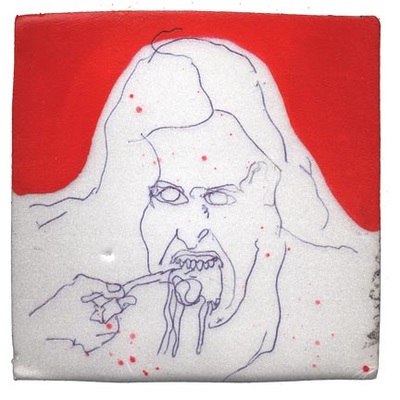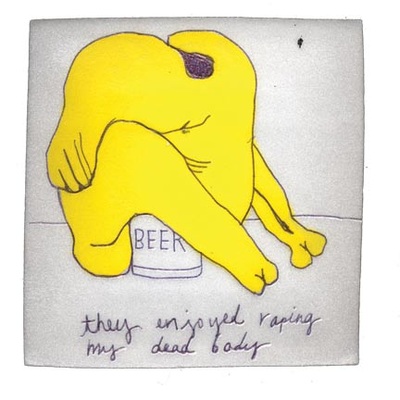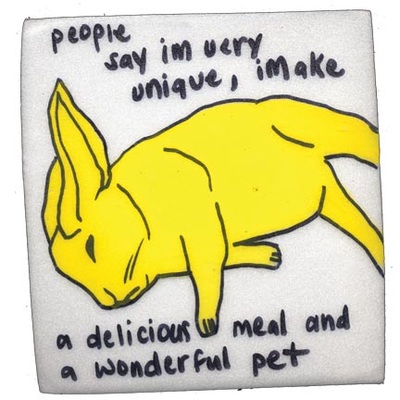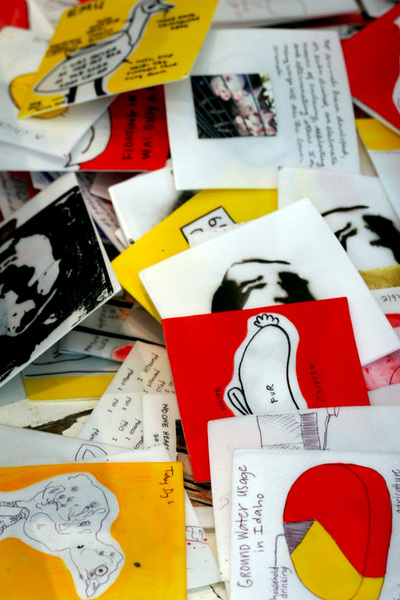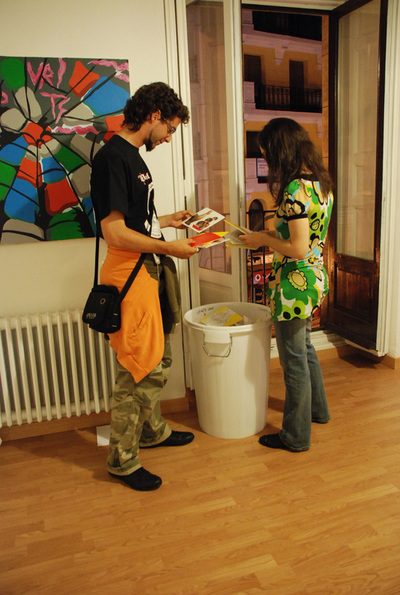Bio-Degraded, collaborative project with A.N.I.M.A.L (Animal/Nature Investigation through Music, Arts and Literature), hundreds of 6" x 6" decorated styrofoam sheets, ballpoint pen, acrylic paint, spray paint, housed in a garbage can and free to take home, shown in Madrid, Spain, 2007.
Billions of non-human animals are killed each year, their bodies shipped long distances to rest on grocery store shelves or among well-decorated restaurant tables. In grocery stores, these animals are usually displayed on styrofoam plates, and at restaurants, the animal corpse remains that are not buried within us, are often taken home in styrofoam boxes. These leftovers often go uneaten and the partial remains stay here in this box, decomposing in a container that will never decompose itself. Most of us are schooled in the evils of styrofoam, this nasty little polystyrene foam polluting the earth, but a lesser known evil contributing to the destruction of the environment and human health are the animal bodies resting inside these clean white boxes. Our guilty conscious may tug on us when we get a box to go, but many of us never consider the devastation our taste for animal flesh invokes, not only on the environment, but also to our health, and most tragically, the animals involved.
Styrofoam: clean, white and sterile, mimics the corpse that rests inside, a body cleverly stripped of all it’s recognizable features that give evidence to it’s former living state, including fur, skin, face, and feet, and whose bodies have been further disguised by cooking, baking and breading. Styrofoam’s clean appearance makes it a perfect container to distance our psyche from the once bloody mess inside, and it’s own culpability in environmental destruction. Yes, these two seem to be a perfect match when you further realize that both are bought and sold at ridiculously cheap prices, prices that hide the true costs of producing them.
Non-human animals are not given the respect they deserve in life or in death, their body parts mutilated, stuffed, and scattered within us and beyond. These animals were a commodity, something to be bought and sold, forgotten as soon as they were born. Help us remember these forgotten lives, hear their stories, and relive their memories by resurrecting a life from the garbage bin. Take a grave home with you, a long-lasting memorial.
Styrofoam: clean, white and sterile, mimics the corpse that rests inside, a body cleverly stripped of all it’s recognizable features that give evidence to it’s former living state, including fur, skin, face, and feet, and whose bodies have been further disguised by cooking, baking and breading. Styrofoam’s clean appearance makes it a perfect container to distance our psyche from the once bloody mess inside, and it’s own culpability in environmental destruction. Yes, these two seem to be a perfect match when you further realize that both are bought and sold at ridiculously cheap prices, prices that hide the true costs of producing them.
Non-human animals are not given the respect they deserve in life or in death, their body parts mutilated, stuffed, and scattered within us and beyond. These animals were a commodity, something to be bought and sold, forgotten as soon as they were born. Help us remember these forgotten lives, hear their stories, and relive their memories by resurrecting a life from the garbage bin. Take a grave home with you, a long-lasting memorial.








